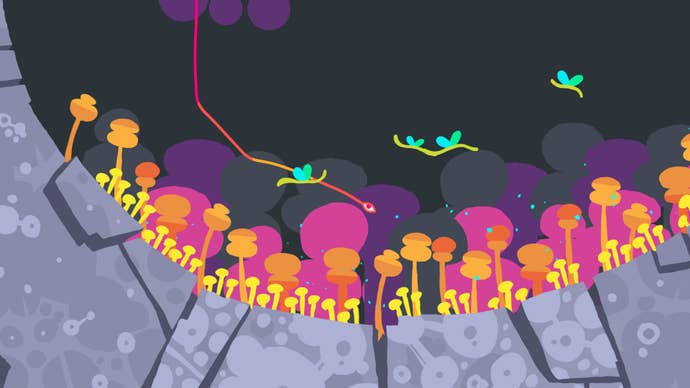Hohokum PS4, PS3, and Vita Review: Floating Free
Join the Long Mover on its journey through worlds of color and music. A zen experience that's not for everyone.
This article first appeared on USgamer, a partner publication of VG247. Some content, such as this article, has been migrated to VG247 for posterity after USgamer's closure - but it has not been edited or further vetted by the VG247 team.
I've been at this for fifteen minutes, trying to find the last thing I need to touch to finish this level. I'm zooming from place-to-place on my psychedelic hypercolor space sperm, trying to figure out what I missed. This is not the first time I've been in this position. It probably won't be the last.
In Hohokum, you control a hue-shifting kite-like creature called the Long Mover who quietly slides through worlds of color and music. You begin the game in this space filled with others of your kind, floating through large empty spaces creating light and sound in your wake. Eventually, your brethren head through a portal into other worlds, where they become hopelessly lost. It's up to you to find them and bring them back to life by helping the denizens of each world.
Hohokum is about simplicity. You only have three direct inputs through various controller combinations: turning, speeding up, or slowing down. There's no extra interaction key, because that happens naturally as you pass by objects. The lack of complex controls means it's easy to pick up Hohokum and start playing. It's easy to get into a flow state, just enjoying the scenery as it shifts around you.

Hohokum is beautiful game. It's all bright colors and simple shapes. (It reminds me of the PSP exclusive LocoRoco.) The world is full of interesting animated inhabitants who coo and hum when you float by. They're happy to see you, sometimes breaking out in song and dance when you complete an objective. In fact, most of your objectives involve aiding the locals in a particular area, making their lives better. You'll cross night-soaked worlds with seas of wine, or bright pastel lands whose flora unfurl when you come close. You'll help a man explore dark caves, carry some workers on your back while they collect a yellow liquid, or move the stars to awaken beasts floating in the night sky. Every world feels like it has a unique fingerprint; the sense of place is strong in Hohokum. Artist Richard Hogg did an amazing job on the game and deserves applause for his work.
The visual feast is backed up by the amazing soundtrack, that mixes traditional music with the sounds that the creatures in each world produces. The music is never overpowering and the creature sounds oddly sync up with it no matter when you activate them. It's like making a tiny symphony every time you play. I recommend Vita players use headphones when playing Hohokum, because the music is an integral part of the experience.

Hohokum is at its best when you're not doing anything in particular. It's relaxing just floating around on your kite-thing, touching whatever you want to. There's a sense of freedom and exploration in coasting from world-to-world. It's great to hop in for 15-20 minutes to fly through a world or two, making it a great Vita game or palate-cleanser between bigger titles. Hohokum is the kind of game that absolutely sings when you're just exploring aimlessly with no clear objective. Finding all of your fellow kite beings brings up the game's credits, but it can continue on forever if you just want to explore. The problem is when it comes crashing down to Earth.
Yesterday, I called P.T. "obtuse" because it consists of running around aimlessly looking at everything until you find the way out. Hohokum is much the same. It provides little context, expecting you to float around touching everything until something big happens. The game is minimalist, so there's no list of objectives; you just touch and activate enough things on-screen to trigger a big change in the setting.
Whether you get along with Hohokum depends on how you approach it. The game explains nothing, leaving everything very opaque. You have to have a very zen mindset about it; what happens will happen. When you try to play it as a traditional game - finish an objective, move onto next objective - then you may find yourself frustrated at times. In fact, I'd almost say that Hohokum is better to watch than it is to play. Specifically trying to get to the end of Hohokum honestly felt like a chore, but I'm a reviewer, so how I played it may not be how you play it. Keep that in mind and you'll find the goodness within Hohokum.

All told, Hohokum is a beautiful experience if you're willing to relax and let things come as they may. Try to play it as a traditional game and you'll probably not enjoy it. It's a visual feast backed by a great soundtrack, and buying the game once gets you the PlayStation 4, PlayStation 3, and PlayStation Vita versions. (Hohokum also features cross-save support so you can hop between all three platforms, but I had a few issues getting it to take every time.) If you're looking for a calm, minimalist zen experience, Hohokum is the game for you.
VisualsHohokum's beautiful art style means it looks great no matter what platform you play it on.
SoundThe soundtrack in Hohokum, composed by Ghost International artists, is a treat.
InterfaceThere's very little interface in Hohokum.
Lasting AppealOnce you've freed all your friends, there's still hidden eyes to open in each level. Outside of that, Hohokum is just a calming experience.
ConclusionHohokum is a different kind of game that prizes aimless interaction and exploration above completing specific objectives. It's a title that brings together a cute, minimal art style and a great soundtrack to create a zen experience. It's worth a play, but not everyone will appreciate its strengths.

